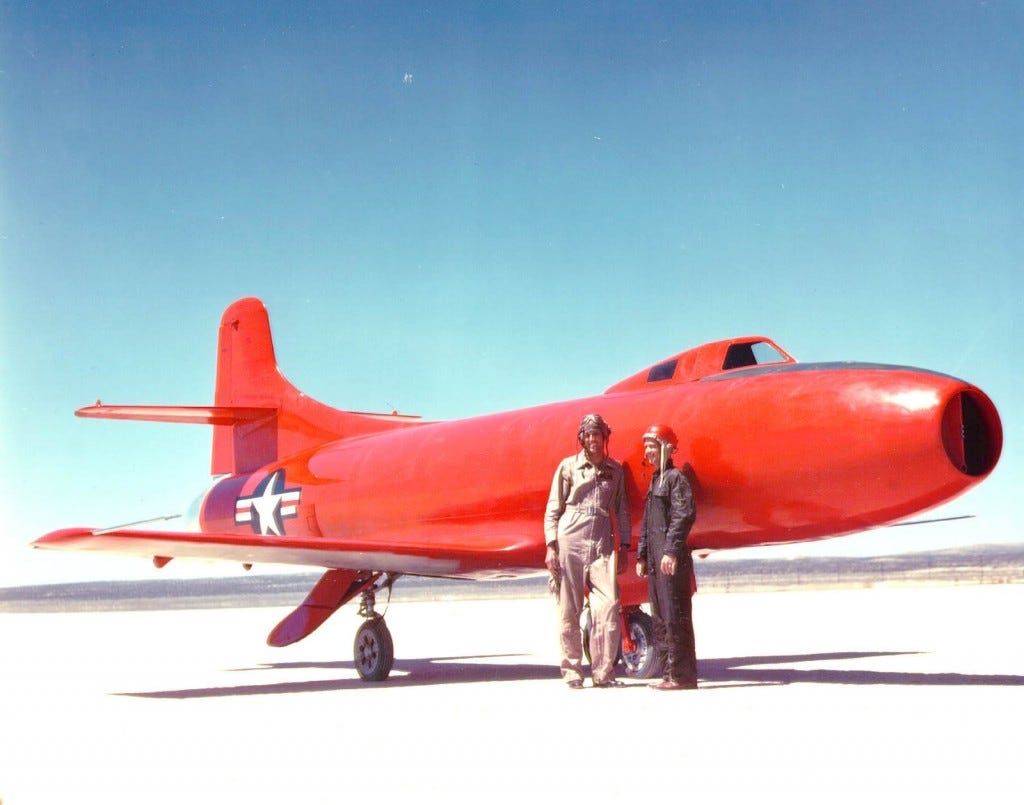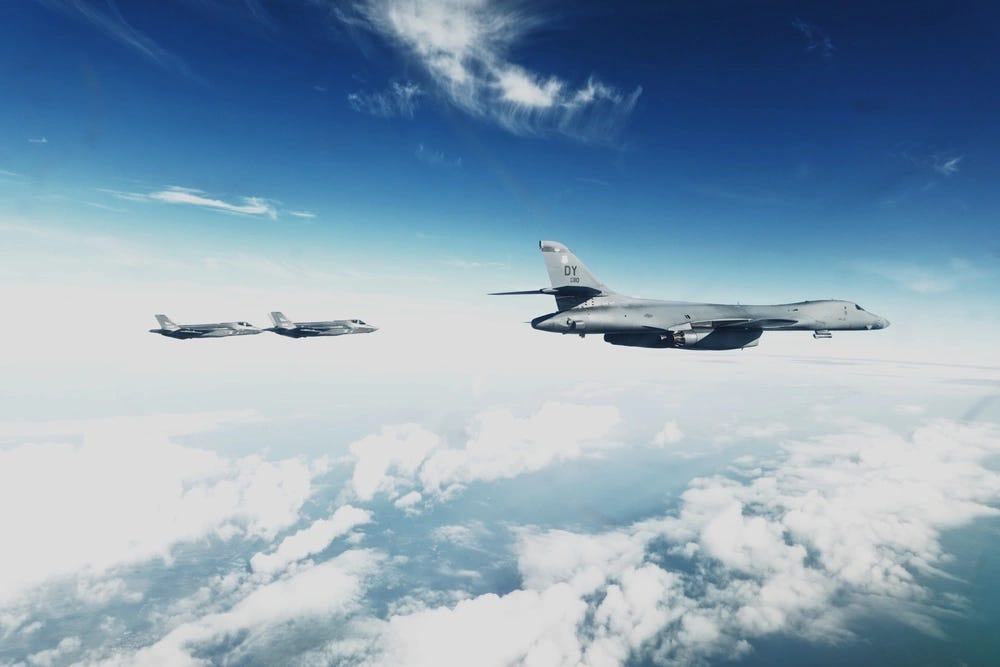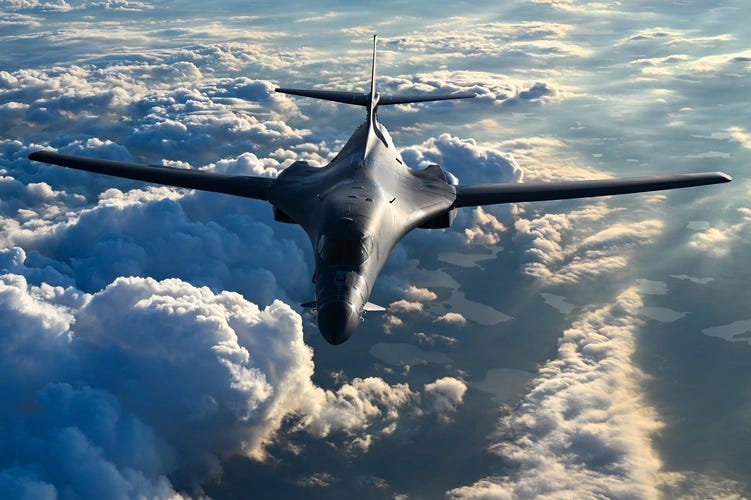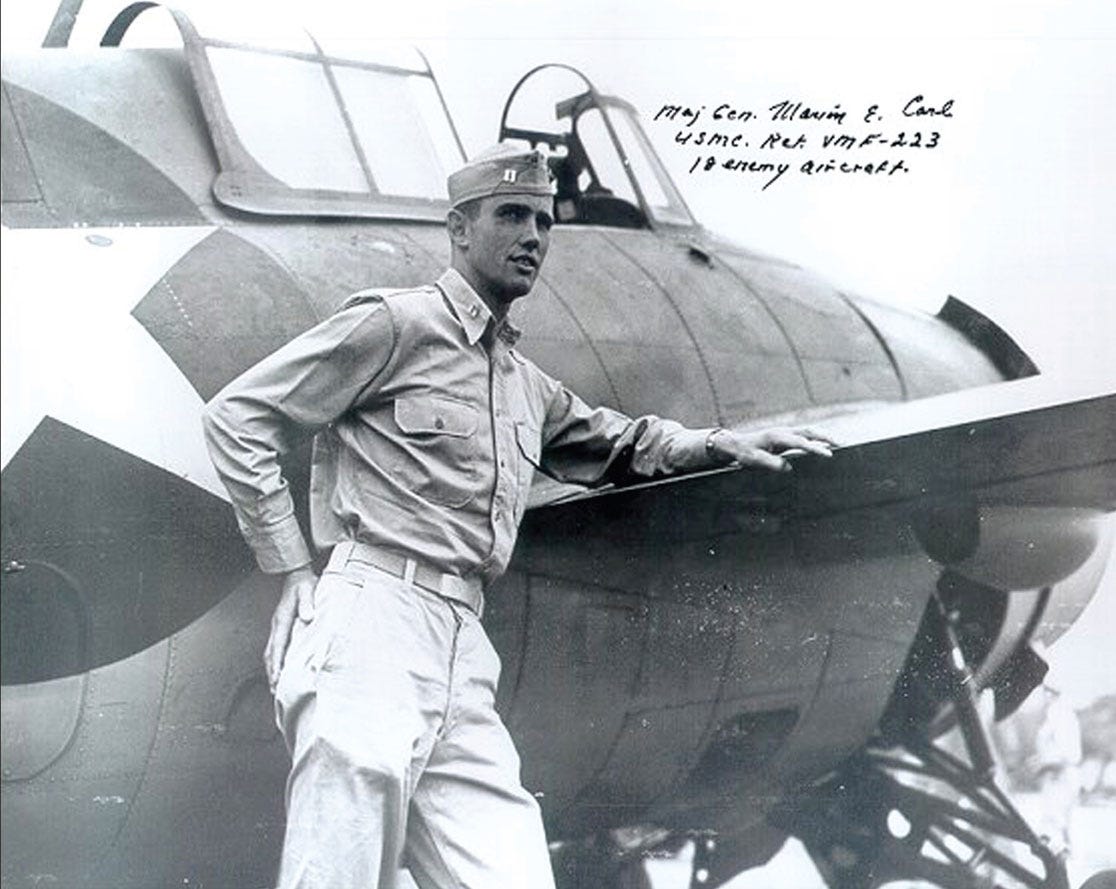Lancers in Norway, Aces Over Guadalcanal
From modern B-1B bomber deployments in Europe to Marion Carl’s rise as the Marine Corps’ first ace, this week’s issue highlights the evolution of airpower from World War II to today.
“The B-1 is the backbone of America’s long-range bomber force—fast, flexible, and capable of striking anywhere in the world on short notice.”
— Gen. Robin Rand, USAF (Ret.), former commander, Air Force Global Strike Command
Mission Briefing
B-1B Lancers Touch Down in Norway for High-End NATO Training
Three U.S. Air Force B-1B Lancer bombers thundered into Ørland Air Base, Norway, on August 9, marking the start of Bomber Task Force Europe 25-4B. The aircraft, from the 345th Expeditionary Bomb Squadron at Dyess AFB, Texas, arrived after a dramatic escort by Spanish EF-18M Hornets over the Arctic—underscoring the multinational character of the mission from the outset.
Once on station, the “BONEs” (as the B-1s are nicknamed) will fly Ally-led missions designed to sharpen the find, fix, track, and target process against simulated high-threat environments. The training emphasizes rapid coordination between bombers, fighters, and support aircraft while countering both ground-based and airborne threats. It’s the kind of integrated rehearsal that tests NATO’s ability to act decisively and seize air superiority in contested skies.
“This deployment allows us to train the way we fight—integrated with our NATO Allies, ready and adaptive,” said Lt. Col. Eric Alvarez, commander of the deployed squadron.
The B-1s will operate alongside Royal Norwegian Air Force F-35s based at Ørland, a pairing that highlights both nations’ commitment to interoperability in Europe’s increasingly strategic High North. Norwegian leaders welcomed the training, noting it enhances readiness and strengthens trust between Allies.
A Surge in Bomber Demand
This marks the fifth BTF deployment to Europe in 2025 alone, part of a relentless global tempo. According to Air Force Global Strike Command chief Gen. Thomas Bussiere, bomber units have been tasked 48 times in just the past 18 months—33 of those in 2024. The demand spans from Europe and the Indo-Pacific to the Middle East, reflecting what Bussiere called an “unyielding” need for bomber presence not seen since the height of the Iraq and Afghanistan wars.
That demand comes at a cost. The B-1 fleet, already strained from years of heavy use and retirement of older airframes, is carrying a growing share of the mission load. Bussiere has even acknowledged that the Air Force may consider pulling a handful of bombers out of long-term storage at Davis-Monthan AFB if required—though he hopes it won’t come to that.
For now, the Ørland deployment highlights a key message: NATO’s heavy hitters can deploy quickly, integrate seamlessly, and operate at the sharp end of high-threat scenarios. For allies, it’s reassurance. For adversaries, it’s a warning.
This Week in Aviation History
Marion Carl Becomes the Marine Corps’ First Ace
24 August 1942 – The skies above Guadalcanal roared with combat as Marine Lieutenant Marion Eugene Carl, flying a Grumman F4F Wildcat with VMF-223, downed four Japanese aircraft in a single day. His kills—a Mitsubishi A6M Zero, a G4M “Betty” bomber, and two Nakajima B5N “Kate” torpedo bombers—cemented his place in history as the first ace of the United States Marine Corps.
It was not Carl’s first taste of victory. Just months earlier, during the Battle of Midway, he had shot down his first enemy Zero and earned the Navy Cross. By the time Guadalcanal’s Henderson Field became the focal point of the Pacific campaign, Carl’s flying skills and relentless courage made him a leader among the Marine aviators struggling to hold the fragile airstrip. His performance that August earned him a second Navy Cross.
The Wildcat at War
Carl’s mount was the Grumman F4F-4 Wildcat, a rugged carrier-borne fighter designed by Robert Leicester Hall. Compact but tough, the Wildcat was built to survive the punishing realities of Pacific air combat. The F4F-4 variant introduced folding wings for carrier storage, carried six .50-caliber Browning machine guns, and was powered by a Pratt & Whitney R-1830 Twin Wasp radial engine producing up to 1,200 horsepower.
Though slower and less agile than the Japanese Zero, the Wildcat could absorb far more punishment and return home with its pilot intact. By war’s end, Wildcats would claim an impressive 9-to-1 kill ratio over Japanese aircraft, proving the design’s resilience and the skill of the aviators who flew it.
Carl’s Career Beyond Guadalcanal
Born in Hubbard, Oregon, in 1915, Marion Carl entered flight training at NAS Pensacola in 1938 and quickly proved himself an exceptional pilot. After Guadalcanal, he went on to command VMF-223, re-equipped with the new F4U Corsair, and finished the war credited with 18½ aerial victories, making him one of the Marine Corps’ top fighter aces.
Carl’s post-war career was no less remarkable. He became a test pilot at NAS Patuxent River, where he flew cutting-edge jets and helicopters and set world records in the Douglas D-558 Skystreak and Skyrocket research aircraft. He later commanded the Marine Corps’ first jet squadron, flew clandestine reconnaissance missions over China, and eventually rose to the rank of Major General.

By the time he retired in 1973, Carl had logged over 13,000 flight hours in everything from biplanes to supersonic jets. His decorations included three Navy Crosses, five Distinguished Flying Crosses, and twelve Air Medals—a testament to a career defined by courage, innovation, and leadership.
Marion Carl’s legacy as the Marine Corps’ first ace is more than a footnote in aviation history—it’s a story of a farm boy from Oregon who became one of America’s great combat pilots and a pioneer of the jet age.
In Case You Missed It
Something a little different this week - I’ve made a trailer for my upcoming B-47 video:
Let me know your thoughts in the comments
Photo Outlet
Every issue of Hangar Flying with Tog gets you a free image that I’ve taken at airshows:
Feel free to use these photos however you like, if you choose to tag me, I am @pilotphotog on all social platforms. Thanks!
Post Flight Debrief
Like what you’re reading? Stay in the loop by signing up below—it’s quick, easy, and always free.
This newsletter will always be free for everyone, but if you want to go further, support the mission, and unlock bonus content, consider becoming a paid subscriber.
Your support keeps this flight crew flying—and I couldn’t do it without you.
– Tog







